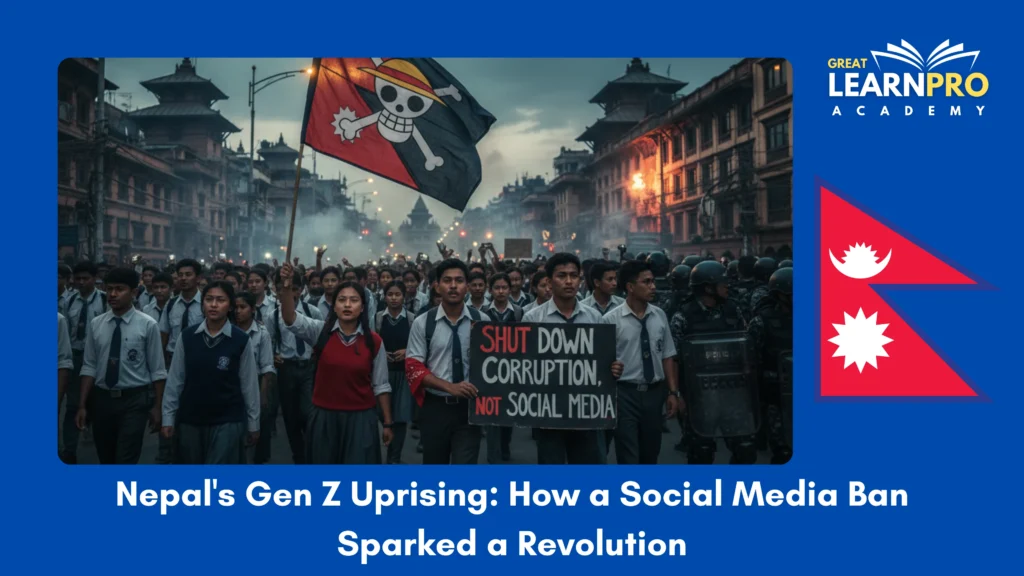
A Nation on the Edge: Nepal’s Gen Z Uprising
Nepal has entered one of its most turbulent political periods in decades. On September 8, 2025, what began as a protest against a sweeping ban on major social media platforms rapidly evolved into a nationwide, youth-driven uprising. The wave of dissent forced Prime Minister K.P. Sharma Oli to resign, brought the army onto the streets, and left many questioning the future trajectory of Nepali governance.
Sparks of Discontent
At the heart of the movement lies a frustration incubated over years: rampant corruption, growing economic disparity, youth unemployment exceeding 20%, and political families flaunting privilege while everyday citizens struggle. When the government abruptly blocked access to platforms like Facebook, Instagram, YouTube, and WhatsApp, young people interpreted it not as necessary regulation, but as censorship and a blatant attack on free expression.
From Virtual to Real Streets
Using alternative digital platforms such as TikTok, Viber, and Reddit to coordinate, Generation Z protesters mobilized en masse, many donning school and college uniforms. Slogans like “Shut down corruption, not social media” and “Youths against corruption” became rallying cries across Kathmandu and beyond. What began as online defiance spilled into streets, with thousands of young Nepalis marching toward the centers of power.
The Clashes Turn Deadly
What started as peaceful demonstrations escalated when police and security forces resorted to lethal force. In the ensuing violence, at least 19 protesters lost their lives, with hundreds more wounded.
Curfews were imposed, the army intervened, and chaotic scenes unfolded government buildings were set ablaze, parliament complexes were stormed, and ministers had to be evacuated by helicopter. Images of tear gas, rubber bullets, and injured students quickly circulated online, further galvanizing the protests.
Political Fallout and Rising Voices
Amid mounting pressure, Prime Minister Oli tendered his resignation, though he remains in office in a caretaker capacity. The real authority of his administration, however, has eroded significantly.
Stepping into the spotlight is Balendra Shah a young, independent mayor of Kathmandu and former rapper who has become a symbol of clean governance and a hero to many protesters. While he has not formally declared his intent to pursue national leadership, his growing popularity reflects a broader yearning for new and untainted political alternatives.
Demands: Beyond One Resignation
Though Oli’s resignation marked a pivotal moment, protesters are not easing their demands. Instead, they are pushing for deeper reforms, including the dissolution of parliament, accountability for corrupt leaders, and a roadmap for a more transparent, inclusive governance structure. Calls for a new constitution and systemic changes to curb entrenched political privilege are gaining momentum.
Why This Movement Matters
- Youth Empowerment: Generation Z has organized one of the most impactful political movements in recent Nepali history, signaling their refusal to accept entrenched corruption and inefficiency.
- Digital Resistance: In the face of censorship, young Nepalis turned to creative tools—TikTok, encrypted chat apps, and even anime symbols like the “One Piece” pirate flag—to assert their presence and identity.
- Democracy’s Fragility: The protests underscore how fragile democratic institutions can be when confronted with authoritarian measures such as sweeping bans on free speech.
- Future of Governance: With widespread calls for structural reform, Nepal stands at a crossroads: embrace change or risk plunging deeper into instability.
Balancing Hope and Uncertainty
The protests have also revealed the generational divide within Nepal. For older leaders, stability often meant maintaining the status quo, even at the cost of democratic vibrancy. For young protesters, stability can only come through accountability, opportunity, and transparent governance.
International observers are closely monitoring the situation. Nepal, nestled between India and China, occupies a sensitive geopolitical space. Continued unrest could have regional implications, particularly if governance reforms are not pursued earnestly.
In Summary
Nepal’s Gen Z uprising is not just about the fall of a prime minister. It is a generational wake-up call, born of anger against corruption, nepotism, censorship, and lack of opportunity. Sparked by a ban on social media but fueled by broader dissatisfaction, the protests have triggered a crisis of legitimacy in Nepali politics.
The resignation of K.P. Sharma Oli may provide temporary relief, but it is clear that the youth movement demands more than symbolic gestures. They are seeking a transformation in how their nation is governed. Whether Nepal’s leaders will seize this moment for reform or allow it to spiral into further instability remains to be seen.
What is certain, however, is that this uprising has already altered the country’s political discourse—placing transparency, youth representation, and democratic accountability at the heart of Nepal’s future.
Sources:
- https://www.google.com/amp/s/m.economictimes.com/news/newsblogs/nepal-gen-z-protest-live-news-updates-kathmandu-curfew-nepal-pm-kp-sharma-oli-resignation-social-media-facebook-youtube-x-instagram-nepal-bannned-latest-updates/amp_liveblog/123784747.cm
- https://www.thehindu.com/news/international/gen-z-protests-nepals-former-chief-justice-sushila-karki-tipped-to-lead-political-transition/article70036440.ece/amp/
- https://www.google.com/amp/s/www.hindustantimes.com/photos/news/rage-ruins-and-resignations-50-photos-that-capture-grim-reality-of-nepal-protests-101757481877751-amp.html
More Current affairs: https://learnproacademy.in/updates/
